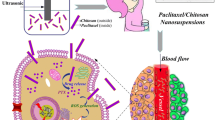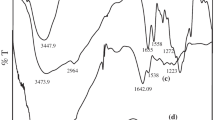ABSTRACT
Purpose
To characterize and evaluate chitosan film containing PLGA nanoparticles (NPs) as a platform for localized dual-drug release.
Methods
Fluorescent Paclitaxel (FPTX), a hydrophobic drug, was incorporated into PLGA NPs. FPTX-loaded PLGA NPs and Carboxyfluorescein (CF), a hydrophilic model drug, were embedded into chitosan films. Release of CF and NPs from chitosan and release of FPTX from PLGA NPs were monitored by fluorescence. The stability of the platform was observed through SEM and dynamic light scattering (DLS).
Results
Chitosan films containing CF and FPTX-loaded PLGA NPs showed a biphasic release profile. In the first phase, 78% of CF and 34% of NPs were released within few days. In the second phase, the release was slower, showing an additional release of 22% of CF and 18% of NPs after 3 weeks. SEM images and DLS measurements showed that NP release depends on film degradation rate. FPTX-loaded PLGA NPs showed the release of 19.8% of total drug in 2 days, and no additional release was detected in the next 26 days.
Conclusions
The ability of chitosan film containing PLGA NPs to coat gold surface and to incorporate and release two different drugs of different hydrophilicity make it a promising platform for localized dual-drug release.






Similar content being viewed by others
REFERENCES
Nunthanid J, Puttipipatkhachorn S, Yamamoto K, Peck G. Physical properties and molecular behavior of chitosan films. Drug Dev Ind Pharm. 2001;27(2):143–57. doi:10.1081DDC100000481.
Xu J, McCarthy SP, Gross RA. Chitosan film acylation and effects on biodegradability. Macromolecules. 1996;29:3436–40. doi:10.1021/ma951638b.
Freier T, Koh HS, Kazazian K, Shoichet MS. Controlling cell adhesion and degradation of chitosan films by N-acetylation. Biomaterials. 2005;26:5872–8. doi:10.1016/j.biomaterials.2005.02.033.
Cardenas G, Anaya P, von Plessing C, Rojas C, Sepulveda J. Chitosan composite films. Biomedical applications. J Mater Sci Mater Med. 2008;19:2397–405. doi:10.1007/s10856-007-3275-3.
Galeska I, Kim T, Patil SD, Bhardwaj U, Chatttopadhyay D, Papadimitrakopoulos F, et al. Controlled release of dexamethasone from PLGA microspheres embedded within polyacid-containing PVA hydrogels. AAPS J. 2005;7(1):E231–9. doi:10.1208/aapsj070122.
Ranganath SH, Kee I, Krantz WB, Chow PK, Wang C. Hydrogel matrix entrapping PLGA-paclitaxel microspheres: drug delivery with near zero-order and implantability advantages for malignant brain tumour chemotherapy. Pharm Res. 2009;26(9):2101–14. doi:10.1007/s1109-009-9922-2.
Mu L, Feng S. PLGA/TPGS nanoparticles for controlled release of paclitaxel: effects of the emulsifier and drug loading ratio. Pharm Res. 2003;20(11):1864–72. doi:10.1023/B:PHAM.0000003387.15428.42.
Jin C, Bai L, Wu B, Song W, Guo G, Dou K. Cytotoxicity of paclitaxel incorporated in PLGA nanoparticles on hypoxic human tumor cells. Pharm Res. 2009;2(7):1776–84. doi:10.1007/s11095-009-9889-z.
Van Vlerken LE, Duan Z, Little SR, Seiden MV, Amiji MM. Biodistribution and pharmacokinetic analysis of palcitaxel and ceramide administred in multifunctional polymer-blend nanoparticles in drug resistant breast cancer model. Mol Pharm. 2008;5(4):516–26. doi:10.1021/mp800030k.
van der Giessen WJ, Lincoff AM, Shwartz RS, van Beusekom HMM, Serruys PW, Holmes DR, et al. Marked inflammatory sequelae to implantation of biodegradable and nonbiodegradable polymers in porcine coronary arteries. Circulation. 1996;94(7):1690–7.
Westedt U, Wittmar M, Hellwig M, Hanefeld P, Greiner A, Schaper A, et al. Paclitaxel releasing films consisting of poly(vinyl alcohol)-graft-poly(lactide-co-glycolide) and their potential as biodegradable stent coatings. J Control Release. 2006;111:235–46. doi:10.1016/j.conrel.2005.12.012.
Heldman AW, Cheng L, Jenkins GM, Heller PF, Kim DW, Ware Jr M, et al. Paclitaxel stent coating inhibits neointimal hyperplasia at 4 weeks in a porcine model of coronary restenosis. Circulation. 2001;103:2289–95.
Garcia-Garcia HM, Vaina S, Tsuchida K, Serruys PW. Drug-eluting stents. Arch Cardiol Méx. 2006;76:297–319.
Gershlick A, De Scheerder I, Chevalier B, Stephens-Lloyd A, Camenzind E, Vrints C, et al. Inhibition of restenosis with a paclitaxel-eluting, polymer-free coronary stent: the European evaLUation of pacliTaxel Eluting Stent (ELUTES) trial. Circulation. 2004;109:487–93. doi:10.1161/01.CIR.0000109694.58299.A0.
Dowdy SC, Jiang S, Zhou XC, Hou X, Jin F, Podratz KC, et al. Histone deacetylase inhibitors and paclitaxel cause synergistic effects on apoptosis and microtubule stabilization in papillary serous endometrial cancer cells. Mol Cancer Ther. 2006;5(11):2767–76. doi:10.1158/1535-7163.MCT-06-0209.
Guo DD, Xu CX, Quan JS, Song CK, Jin H, Kim DD, et al. Synersgistic anti-tumor activity of paclitaxel-incorporated conjugated linoleic acid-coupled poloxamer thermosensitive hydrogel in vitro and in vivo. Biomaterials. 2009;30:477–4785. doi:10.1016/jbiomaterials.2009.05.051.
Pentheroudakis G, Razis E, Athanassiadis A, Pavlidis N, Fountzilas G. Paclitaxel-carboplatin combination chemotherapy in advanced breast cancer. Med Oncol. 2006;23(2):147–160.
Wurm RE, Gum F, Erbel S, Schlenger L, Scheffler D, Agaoglu D, et al. Image guided respiratory gated hypofractionated Stereotactic Body Radiation Therapy (H-SBRT) for liver and lung tumors: Initial experience. Acta Oncol. 2006;45:881–9. doi:10.1080/02841860600919233.
Cui Y, Dy JG, Sharp GC, Alexander B, Jiang SB. Multiple template-based fluoroscopic tracking of lung tumor mass without implanted fiducial markers. Phys Med Biol. 2007;52:6229–42. doi:10.1088/0031-9155/52/20/010.
Cui Y, Dy JG, Alexander B, Jiang SB. Fluoroscopic gating without implanted fiducial markers for lung cancer radiotherapy based on support vector machines. Phys Med Biol. 2008;53:N315–27. doi:10.1088/0031-9155/53/16/N01.
Shirkhanzadeh M. Nanoporous alkoxy-derived titanium oxide coating: a reactive overlayer for functionalizing titanium surface. J Mater Sci Mater Med. 1998;9:355–62. doi:10.1023/A:1008859131585.
Gultepe E, Nagesha D, Menon L, Busnaina A, Sridhar S. High-throughput assembly of nanoelements in nanoporous alumina templates. Appl Phys Lett. 2007;90:163119. doi:10.1063/1.2730575.
Gultepe E, Nagesha D, Casse BDF, Banyal R, Fitchorov T, Karma A, et al. Sustained drug release from Non-eroding Nanoporous templates. Small. 2010;6(2):213–6. doi:10.1002/smll.200901736.
Cormack R, Sridhar S, Suh W, D’Amico A, Makrigiorgos M. Biological in situ dose-painting for image-guided radiation therapy using drug-loaded implantable devices. Int J Radiat Oncol Biol Phys. 2009. doi: 10.1016/j.ijrobp.2009.06.039.
Fukumori Y, Ichikawa H. Nanoparticles for Cancer therapy and diagnosis. Adv Powder Technol. 2006;17(1):1–28. doi:10.1163/156855206775123494.
ACKNOWLEDGEMENTS
The authors thank Dr. Bernard D. F. Casse, William Fowle and Electronic Materials Research Institute of Northeastern University for SEM images. This work was supported by the IGERT Nanomedicine Science and Technology Program (NSF-0504331) and Brigham Womens Hospital.
Author information
Authors and Affiliations
Corresponding author
Rights and permissions
About this article
Cite this article
Tada, D.B., Singh, S., Nagesha, D. et al. Chitosan Film Containing Poly(D,L-Lactic-Co-Glycolic Acid) Nanoparticles: A Platform for Localized Dual-Drug Release. Pharm Res 27, 1738–1745 (2010). https://doi.org/10.1007/s11095-010-0176-9
Received:
Accepted:
Published:
Issue Date:
DOI: https://doi.org/10.1007/s11095-010-0176-9




